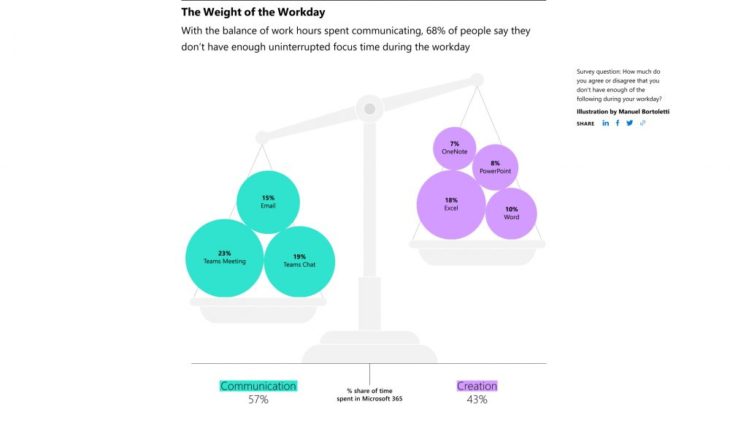From autopilot to copilot: How will AI change our (working) life?
- May 10, 2023
- 0
In the Work Trend Index, Microsoft takes a look at the future of work and life every year. A future in which AI will play a major role.
In the Work Trend Index, Microsoft takes a look at the future of work and life every year. A future in which AI will play a major role.
In the Work Trend Index, Microsoft takes a look at the future of work and life every year. A future in which AI will play a major role.
Yesterday Microsoft released the Work Trend Index 2023, a report based on a survey of 31,000 employees from 30 different countries. Through the survey, Microsoft has its finger on the pulse of what’s happening in the world of work every year. Microsoft shows that it is up to date: while last year the focus was still on the challenges of hybrid work, this year’s research is devoted entirely to the topic of AI, which is currently being discussed in the technology industry.
However, there is a caveat on this subject. With the multi-billion dollar investment in OpenAI, Microsoft has linked its future to the big breakthrough in artificial intelligence. Not entirely coincidentally, Microsoft announced the wider availability of Copilot, an AI assistant for the 365 portfolio, at the same time as the study. You can already guess that the research will paint a rather positive picture of the role of AI in our everyday (work) life before you read the research.
Employees today are inundated with notifications and data. The hybrid working model, which wants to be available anytime and anywhere, has not contributed to the mental calming of the employees. The Work Trend Index Report speaks of “digital debt”: 68 percent of the employees surveyed complain about not having enough focus time during the working day, 64 percent state that they feel less energetic and creative due to the higher workload.
Video meetings, in which Microsoft sometimes lends a hand, turn out to be the big culprits. Since February 2020, the last month of the “pre-Corona era”, the number of weekly team meetings for the average employee has tripled. An analysis of the use of Microsoft 365 applications shows that Teams meetings take up an average of 23 percent of the working time, another 19 percent is spent on answering chat messages and 15 percent on emails.
In an 8-hour workday, this means employees spend 4.5 hours communicating at the expense of more creative pursuits. However, there is an urge among employees to attend as many meetings as possible for fear of missing important information. Inefficient or useless meetings are therefore cited as the biggest obstacle to productivity.

The solution to the focus problem? Artificial intelligence. Pessimists sometimes predict that AI will put millions of people out of work, but this doomsday picture is only partially correct, according to the Microsoft study. 49 percent of those surveyed fear that AI can replace them in the long term. On the other hand, 70 percent would like to outsource tasks to AI in order to reduce their own workload. These numbers align with research from Salesforce.
AI can help in various areas. 31 percent of executives believe technology can increase employee productivity. Employees themselves see the greatest benefits in being able to do the same work in less time (33 percent), learning skills faster (30 percent), and being able to better allocate time and energy (26 percent). Concrete applications for AI that are often mentioned are information searches (86 percent), summarizing meetings (80 percent), analysis (79 percent), planning (77 percent) and administration (76 percent), but also creative work such as brainstorming ( 76 percent). Percent). ) and improving human labor (75 percent).
In the digital age, an “alliance” is therefore emerging between AI and humans. Or as Microsoft poetically describes it: AI is no longer an autopilot, but a copilot.
Although meetings are often perceived as a hindrance to productivity, we still feel compelled to attend every meeting.
This optimistic view of the future quickly gives way to realism in the present. 82 percent of executives say employees need to acquire new skills to learn how to use AI efficiently in the future. Microsoft sees up to 33x more job postings related to ChatGPT or any other generative AI on its subsidiary LinkedIn platform than a year ago.
What skills are in demand right now? The analytical ability to determine when an AI can be deployed is unsurprisingly high on the wish list. But the flexibility to use AI, emotional intelligence, creative evaluation, intellectual curiosity, the ability to spot bias in AI output, and writing prompts will also become more important.
This need for new skills is causing some concern for employees. 60 percent of employees say they don’t currently have the right skills. To realize its full potential, organizations must not only teach their employees how to work with AI, but also how to live with it.
Source: IT Daily
As an experienced journalist and author, Mary has been reporting on the latest news and trends for over 5 years. With a passion for uncovering the stories behind the headlines, Mary has earned a reputation as a trusted voice in the world of journalism. Her writing style is insightful, engaging and thought-provoking, as she takes a deep dive into the most pressing issues of our time.